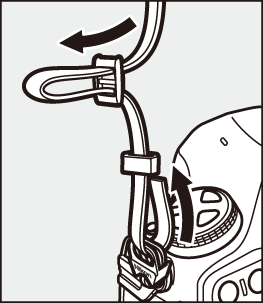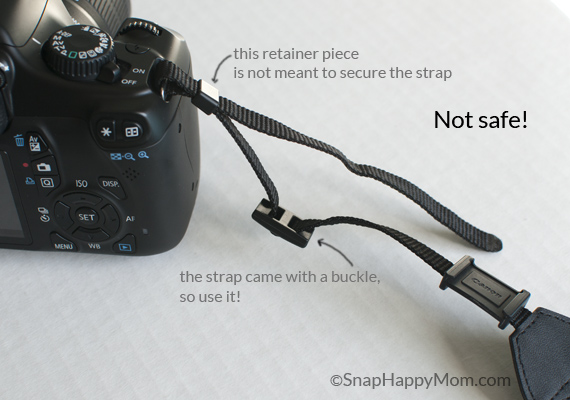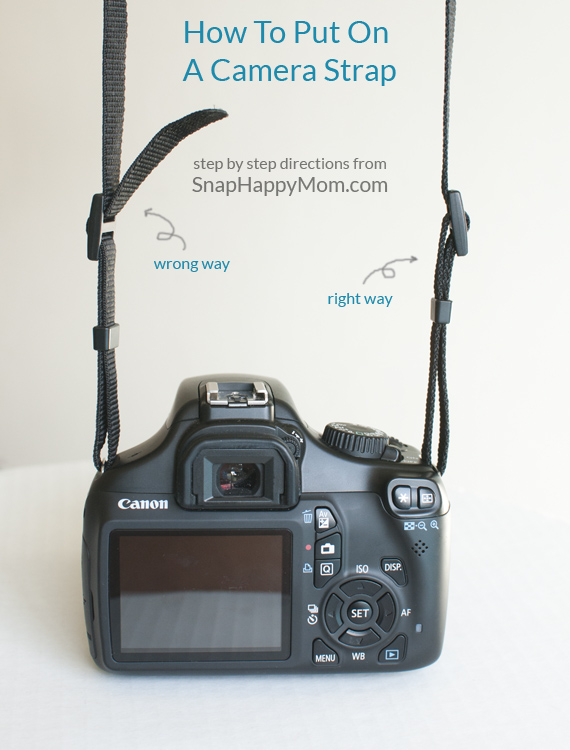To put a camera strap on, thread one end of the strap through the camera’s strap lug. Have you ever struggled with putting on a camera strap?
Properly attaching a camera strap is essential for keeping your camera secure while shooting. Camera straps provide comfort and convenience, allowing you to carry your camera easily and safely. In this guide, we will walk you through the simple steps to correctly put on a camera strap without any hassle.
By following these instructions, you can ensure that your camera is securely attached to you, giving you peace of mind while capturing those perfect shots. Let’s dive in and learn the proper way to put on a camera strap.

Credit: onlinemanual.nikonimglib.com
Choosing The Right Camera Strap
When it comes to photography, having a reliable camera strap is essential. It not only keeps your camera secure but also ensures comfort during long shoots. However, with numerous options available, choosing the right camera strap can be overwhelming. In this article, we will guide you through the process of selecting the perfect camera strap for your needs.
Consider Your Camera’s Weight And Size
The first factor to consider while selecting a camera strap is the weight and size of your camera. Different cameras have varying weights and dimensions, so it’s crucial to choose a strap that can handle the load. A heavy DSLR camera, for instance, requires a sturdy and wider strap to evenly distribute the weight across your shoulder or neck.
On the other hand, if you have a lightweight mirrorless camera, you might opt for a lighter, more compact strap that offers sufficient support without unnecessary bulk. Remember, comfort is key when you’re spending long hours capturing those perfect shots.
Evaluate Strap Options Available
With a multitude of strap options on the market, it’s essential to evaluate each one’s features and benefits before making a decision. Here are a few popular camera strap options:
- Nylon Straps: These are cost-effective and durable, making them a popular choice for photographers of all levels. They come in various widths, lengths, and designs to suit individual preferences.
- Leather Straps: Known for their style and timeless appeal, leather straps offer durability and a comfortable feel. They often come with padding or textured surfaces to prevent slippage.
- Sling Straps: Sling straps are a popular choice for those who need quick access to their cameras. These straps allow you to carry the camera across your body, ensuring it’s always within reach.
- Custom Straps: For those looking to make a style statement, custom camera straps are a great option. These straps can be personalized with unique patterns, colors, and even your name or logo.
It’s important to take your shooting style, preferences, and budget into account when exploring these options. Consider factors such as ease of use, adjustability, and quality of materials to find the strap that best suits your needs.

Credit: snaphappymom.com
Preparing For Strap Attachment
Preparing the camera for strap attachment is an essential step to ensure the safety and security of your camera. Before attaching the camera strap, you need to prepare the camera by clearing the mounts and inspecting the attachments to ensure everything is in good condition.
Clear The Camera Strap Mounts
Before attaching the camera strap, it’s important to clear the camera strap mounts of any debris or dust that may have accumulated. This can be done by gently blowing air around the mounts or using a soft brush to remove any particles that could interfere with the strap attachment.
Inspect The Camera Strap And Attachments
Before attaching the camera strap, it’s crucial to carefully inspect both the strap and the attachments to ensure that everything is in good working condition. Check for any signs of wear or damage on the strap itself, as well as on the attachment points. Ensure that the attachments are securely fastened and that there are no weak points that could compromise the safety of the camera.
“` I hope this meets your requirements. Let me know if you need any further assistance!Attaching The Camera Strap
When putting on a camera strap, hold the strap and thread it through the small metal loop on the camera. Pull the strap through and loop it back over the small metal buckle to secure it in place. Adjust the length of the strap as needed for comfort.
Locate The Camera Strap Mounts
On your camera, find the designated points to attach the strap securely.
Thread The Strap Through The Mounts
Take the strap and insert one end through the first mount then pull it through.
Next, guide the other end through the second mount, ensuring it is securely in place.
Adjusting The Camera Strap Length
When it comes to ensuring optimal comfort and functionality while using your camera, adjusting the camera strap length is imperative. Follow these steps to modify the length of your camera strap to your liking.
Find The Strap Adjustment Mechanism
Locate the strap adjustment mechanism on your camera strap. It is usually found near the connection points where the strap attaches to the camera body.
Modify The Strap Length To Your Preference
To lengthen or shorten the camera strap, pull the strap through the adjustment mechanism and secure it in place by sliding the buckle to tighten. Make sure the length is comfortable for your usage.
Ensuring Secure Attachment
When putting a camera strap on, ensuring a secure attachment is vital for the safety of your equipment and ease of use. Here are some important steps to follow when attaching your camera strap.
Double-check The Strap Threading
Before securing the camera strap, it’s essential to double-check the threading to avoid any potential issues. Make sure the strap is threaded through the correct camera loops or mounting points, following the manufacturer’s instructions if available. This meticulous step ensures proper alignment and reduces the risk of the strap coming loose during use.
Test The Strap’s Stability
After threading the camera strap, it’s crucial to test its stability. Gently pull on the strap to ensure it’s securely attached to the camera. Inspect the connection points to verify that the strap is firmly in place. This step helps prevent accidental detachment while carrying or using the camera in various positions.
Using The Camera Strap Properly
Wearing a camera strap may seem straightforward, but there is actually a proper way to utilize it for optimal stability and comfort. Learning how to wear the camera strap correctly will not only protect your precious gear but also prevent strain on your body during those long photography sessions. In this post, we will guide you through the steps to wear your camera strap properly and explain the benefits of utilizing it for added stability.
Learn How To Wear The Camera Strap
Wearing your camera strap correctly is essential to ensure that your equipment stays secure and easily accessible. Follow these simple steps to learn how to wear your camera strap:
- Identify the strap: Most camera straps have two ends – one with a buckle or clip and the other with a loop or small metal ring.
- Locate the camera strap connectors: Look for small metal connectors on your camera body or camera bag where the strap can be attached.
- Attach the strap to the camera: Connect one end of the camera strap to each connector, making sure they are securely fastened.
- Adjust the length: Slide the buckle or adjuster on the strap to adjust the length according to your preference. Ensure it’s comfortable and provides easy access to your camera without being too loose or tight.
Wearing your camera strap correctly is the first step in utilizing it for added stability.
Utilize The Strap For Added Stability
Once you have your camera strap securely fastened, it’s time to take advantage of the added stability it provides. Here are some benefits of utilizing the camera strap:
- Reduced chance of accidental drops: By keeping the camera securely attached to your body, you minimize the risk of accidental drops or damage.
- Hands-free convenience: When you’re not actively using the camera, letting it hang from your neck or shoulder provides hands-free convenience, allowing you to focus on other tasks.
- Improved stability and control: The camera strap acts as a stabilizer, reducing camera shake and improving your ability to capture clear and sharp images.
- Quick access for capturing moments: With the camera strap properly worn, your camera is always within reach, enabling you to capture spur-of-the-moment shots without fumbling around for your gear.
Remember, while the camera strap can increase stability, it’s important to hold your camera with both hands when actively shooting to ensure steady and controlled movements.
Caring For The Camera Strap
Once you’ve learned how to put a camera strap on, it’s important to know how to properly care for and maintain it. By regularly cleaning and avoiding common mistakes that can damage the strap, you can ensure it remains in good condition for years to come. Here are some tips to help you care for your camera strap:
Clean And Maintain The Strap Regularly
Regular cleaning is essential to keep your camera strap looking and functioning at its best. To clean the strap, follow these simple steps:
- Detach the strap from your camera.
- Wash the strap by hand using mild soap and warm water.
- Gently scrub the strap using a soft brush or sponge to remove any dirt or stains.
- Rinse the strap thoroughly with clean water.
- Wipe away excess water with a clean towel.
- Leave the strap to air dry completely before reattaching it to your camera.
By cleaning your camera strap regularly, you can prevent the buildup of dirt, sweat, and oils, which can cause the strap to deteriorate over time.
Avoid Common Mistakes That Can Damage The Strap
To ensure your camera strap lasts as long as possible, it’s important to avoid certain common mistakes that can cause damage. Here are some key points to remember:
- Avoid overloading the strap: Camera straps are designed to hold a certain weight, so avoid attaching heavy accessories or carrying excessive weight on the strap.
- Avoid sharp or abrasive surfaces: Be cautious when setting your camera down or placing it on rough surfaces, as this can lead to scratches or tears in the strap.
- Check for any signs of wear and tear: Regularly inspect your camera strap for fraying, loose threads, or any other signs of damage. If you notice any issues, it’s important to address them promptly.
- Store the strap properly: When not in use, store your camera strap in a clean, dry place to prevent any damage or deterioration.
By following these tips, you can protect your camera strap from unnecessary damage and ensure it remains in great condition for all your photography adventures.

Credit: m.youtube.com
Conclusion
In short, learning how to put a camera strap on is a simple yet crucial task for any photographer. By following the steps outlined in this guide, you can ensure the safety of your camera and take the best shots possible.
Don’t overlook the importance of securing your camera with a properly fitted strap—it’s an essential aspect of photography that shouldn’t be taken lightly.


0 comments